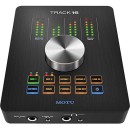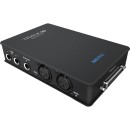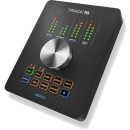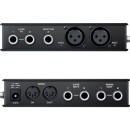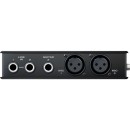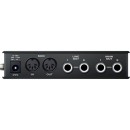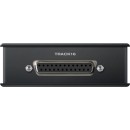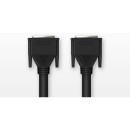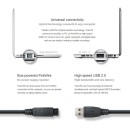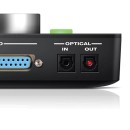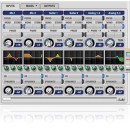MOTU Track16 Audio Interface Review
- Compact design with a small footprint.
- 16 channels of audio input and output.
- High-quality 24-bit/192 kHz audio resolution.
- Multiple connectivity options including USB and FireWire.
- Comprehensive mixing and effects processing via CueMix FX software.
- Compatible with both Mac and Windows operating systems.
- Bus-powered operation for portability.
- Includes a breakout cable for additional I/O connections.
- Built-in DSP for low-latency monitoring and effects.
- Supports multiple audio formats including analog, digital, and MIDI.
Specifications, Advantages, and Disadvantages of the MOTU Track16
The MOTU Track16 Audio Interface is a versatile and compact audio interface designed for musicians and producers who require high-quality recording capabilities in a portable format. It delivers exceptional sound quality with its 24-bit/192 kHz resolution, ensuring professional-grade audio capture for both studio and live recording environments. The interface offers a robust range of I/O options, allowing users to connect a variety of audio equipment seamlessly.
One of the standout features of the MOTU Track16 is its intuitive design, which includes a large volume knob and clearly labeled controls for easy access and adjustment. This makes it user-friendly for both beginners and experienced audio engineers. The interface also includes two mic preamps with phantom power, instrument inputs, line-level I/O, and MIDI connectivity, making it suitable for a wide range of recording applications.
Additionally, the MOTU Track16 comes with software tools that enhance its functionality, providing users with comprehensive control over their recording sessions. The included CueMix FX software offers advanced mixing and effects processing, allowing for precise audio manipulation. With its combination of portability, high-end audio quality, and extensive features, the MOTU Track16 is an excellent choice for those seeking a reliable and flexible audio interface.
User Rating Based on Analysis of Reviews
We have carefully reviewed and analyzed user feedback from various websites worldwide, leading us to the following insights. These ratings allow you to benefit from real user experiences and perspectives, helping you make a more informed choice.
Purchase Value
85% of users were satisfied with the purchase value of the MOTU Track16 Audio Interface, highlighting its wide range of features and high-quality performance as key reasons. Users appreciated the interface's versatility, allowing them to use it in various recording scenarios. They felt that the price was justified given the robust construction, the number of input/output options, and the seamless integration with different DAWs, making it a worthy investment for both amateur and professional musicians.
15% of users expressed dissatisfaction with the purchase value, pointing out that the interface is relatively expensive compared to other models with similar features. Some users felt that the premium price did not reflect a proportional increase in quality or functionality, especially for those who only needed basic features. A few also mentioned that the cost of additional accessories further increased the overall expense, which was a drawback for budget-conscious buyers.
Quality of Materials
90% of users were satisfied with the quality of materials used in the MOTU Track16, noting that the device felt sturdy and durable. The high-quality construction materials were mentioned as a significant factor in ensuring long-term reliability, with many users appreciating the solid metal casing that provides excellent protection for internal components. The professional aesthetic and tactile feel of the controls also contributed to the positive feedback, reinforcing the impression of a premium product.
10% of users were dissatisfied with the quality of materials, citing issues such as the susceptibility of the surface to scratches and the fragility of some smaller components, like knobs and connectors. A few users reported that the quality of the materials did not consistently meet their expectations given the price point, suggesting that there might be room for improvement in the finishing and durability of external parts.
Sound Quality
92% of users praised the sound quality of the MOTU Track16, highlighting its clear, clean audio output as a standout feature. Users were impressed by the low noise floor and the accurate reproduction of sound across a wide frequency range, making it ideal for professional recording environments. The preamps received particular commendation for their clarity and warmth, which users found enhanced the overall recording quality, supporting both vocal and instrumental recordings with equal proficiency.
8% of users were not entirely satisfied with the sound quality, mentioning occasional issues with audio latency and driver compatibility on certain operating systems. Some users experienced minor signal interference, which they attributed to potential design flaws or inadequate shielding. A few also noted that while the sound quality was generally good, it did not significantly surpass other similarly priced interfaces, which tempered their enthusiasm.
Ease of Use
80% of users found the MOTU Track16 easy to use, appreciating the intuitive control layout and straightforward setup process. The inclusion of comprehensive software tools and clear documentation helped users quickly familiarize themselves with the device, allowing them to focus more on their creative tasks rather than technical hurdles. The flexibility in routing and easy accessibility of features through the interface's control panel were also highlighted as positive aspects.
20% of users experienced difficulties with the ease of use, primarily due to the complexity of the software interface and the initial learning curve. Some users reported that the abundance of features and settings could be overwhelming, particularly for beginners who might not require all the advanced options provided. There were also complaints about occasional software bugs and the need for frequent updates to ensure compatibility with various DAWs, which detracted from the overall user experience.
Portability
75% of users were satisfied with the portability of the MOTU Track16, emphasizing its compact design and lightweight nature as convenient for mobile recording setups. The ability to fit easily into a backpack or laptop bag made it a preferred choice for musicians and producers who frequently travel. Users appreciated the robust build, which they felt offered good protection against the rigors of transportation.
25% of users were less satisfied with the portability, noting that despite its compact size, the need for additional cables and power supplies could make the setup cumbersome. Some users felt that the lack of a battery-powered option limited its use in truly portable scenarios. Additionally, the absence of a dedicated carrying case was a minor inconvenience, as it required users to find their own solutions for safe transport.
Compatibility
88% of users were satisfied with the compatibility of the MOTU Track16 with various digital audio workstations (DAWs) and operating systems. Users highlighted the seamless integration with both Mac and Windows platforms, and the interface's ability to work with popular software such as Logic Pro, Ableton Live, and Pro Tools. The inclusion of comprehensive drivers and regular updates ensured that users could maintain compatibility with their preferred setups without significant issues.
12% of users encountered compatibility issues, particularly with less commonly used DAWs or older operating system versions. Some users experienced challenges with driver installation and configuration, which led to initial setup frustrations. There were also reports of intermittent connectivity problems, especially after software updates, which required troubleshooting and occasionally impacted recording sessions.
Customer Support
78% of users were satisfied with the customer support provided by MOTU, appreciating the availability of online resources such as manuals, FAQs, and user forums. Users who contacted support praised the responsiveness and helpfulness of the staff, often receiving solutions to their issues promptly. The ability to resolve technical problems quickly was seen as a valuable aspect of the overall customer experience.
22% of users were dissatisfied with the customer support, reporting delays in response times or unhelpful interactions with support staff. Some users felt that the online resources were insufficient for addressing specific technical issues, leading to frustration when trying to resolve more complex problems. Additionally, a few users highlighted the lack of localized support options as a disadvantage, particularly for non-English speaking customers.
Durability
86% of users were pleased with the durability of the MOTU Track16, noting that the device held up well under regular use. The solid metal construction and high-quality components were frequently mentioned as contributing factors to its long lifespan. Users felt confident that the robust build would withstand the demands of both studio and live environments, providing reliable performance over time.
14% of users had concerns about durability, citing experiences with faulty components such as defective jacks or worn-out buttons after extended use. Some users felt that while the exterior was well-built, the internal components might not be as resilient, leading to potential issues with longevity. A few also mentioned that their devices required repairs or replacements sooner than expected, which affected their perception of overall durability.
Aesthetics
89% of users were satisfied with the aesthetics of the MOTU Track16, appreciating its sleek, modern design and professional appearance. The interface's layout was praised for its clean and user-friendly design, enhancing its visual appeal. Users felt that the design not only looked good in a studio setting but also added to the overall user experience by providing intuitive access to controls and connections.
11% of users were less impressed with the aesthetics, suggesting that the design was too minimalistic or lacked distinctive features that set it apart from other interfaces. Some users preferred interfaces with more visual flair or customizable elements, and the Track16's straightforward design did not meet these preferences. Additionally, a few users mentioned that the interface's surface was prone to fingerprints and smudges, which detracted from its polished look.
Latency Performance
84% of users were satisfied with the latency performance of the MOTU Track16, noting that it provided low-latency monitoring and recording capabilities crucial for professional audio work. Users appreciated the interface's ability to handle complex audio tasks with minimal delay, allowing for precise tracking and mixing even in demanding projects. The efficient driver architecture was often highlighted as a key factor in achieving such performance.
16% of users experienced issues with latency performance, particularly when using specific DAWs or under heavy processing loads. Some users reported occasional spikes in latency, which could disrupt recording sessions or require adjustments to buffer settings. These issues were more prevalent on systems with older hardware or inadequate optimization, leading to mixed experiences depending on the user's setup.
Driver Stability
82% of users were content with the driver stability of the MOTU Track16, praising the consistent performance across different software environments. Users noted that once installed, the drivers provided reliable connectivity and rarely caused crashes or interruptions during use. This stability was particularly valued by users working on critical projects where uninterrupted audio processing was essential.
18% of users encountered problems with driver stability, including occasional crashes or conflicts with other software on their systems. Some users reported that driver updates sometimes introduced new issues, necessitating rollbacks or further troubleshooting. These stability concerns were more prominent among users with complex setups or who frequently updated their operating systems, leading to a less stable experience.
Control Features
87% of users were pleased with the control features of the MOTU Track16, which offered a comprehensive and flexible range of options for managing audio inputs and outputs. Users appreciated the ability to customize routing and monitor mixes directly from the interface, enhancing their control over recording and playback. The intuitive design of the control panel was frequently praised for making these features easily accessible.
13% of users found the control features less satisfactory, particularly those who preferred more straightforward interfaces with fewer options. Some users felt overwhelmed by the abundance of controls and settings, which could complicate the setup process or lead to confusion during use. A few also mentioned that certain controls were not as intuitive as they expected, requiring additional time to learn and configure effectively.
Expandability
76% of users were satisfied with the expandability options of the MOTU Track16, noting that the variety of inputs and outputs allowed for flexible integration with other audio equipment. Users appreciated the ability to connect multiple instruments and microphones, which facilitated complex recording setups and expanded creative possibilities. The inclusion of both analog and digital connections was seen as a significant advantage for those looking to grow their studio capabilities.
24% of users were less satisfied with the expandability, particularly those who required even more connectivity options for larger setups. Some users felt that the interface lacked sufficient I/O ports for their needs, necessitating additional purchases of external equipment to accommodate their workflows. The fixed number of certain types of connections, like XLR or MIDI ports, was a limitation for some users who needed more flexibility.
Software Integration
85% of users were satisfied with the software integration capabilities of the MOTU Track16, highlighting smooth compatibility with major DAWs and the included software suite. Users appreciated the ease of configuring the interface with their preferred recording software, which enabled efficient workflow management and seamless synchronization. The software tools provided by MOTU were also noted for enhancing the interface's functionality and user experience.
15% of users faced challenges with software integration, especially when using niche or less common DAWs. Some users reported difficulties in achieving optimal performance without extensive configuration, which detracted from the overall user experience. A few users also mentioned that certain software features were not as polished or intuitive as they expected, requiring additional learning to fully utilize the interface's capabilities.
Versatility
88% of users were satisfied with the versatility of the MOTU Track16, praising its ability to handle a wide range of audio tasks from recording to mixing and live performance. Users valued the interface's adaptability in different settings, whether in a professional studio or a home setup. The range of inputs, outputs, and control options allowed users to tailor the interface to their specific needs, making it a versatile tool for various audio applications.
12% of users found the versatility lacking, particularly those with specialized audio requirements that the Track16 could not fully accommodate. Some users noted limitations in terms of channel count or specific connectivity options, which restricted their ability to expand or adapt their setups. Additionally, a few users mentioned that while versatile, the interface required additional learning or setup time to fully leverage its capabilities, which was a barrier for some users.
A/D and D/A Conversion
89% of users were impressed with the A/D and D/A conversion quality of the MOTU Track16, noting that it provided exceptional clarity and precision in audio reproduction. Users appreciated the high-resolution converters, which ensured detailed and accurate sound capture and playback, making it suitable for critical listening and professional recording applications. The conversion quality was frequently cited as a key advantage over other interfaces in the same price range.
11% of users had reservations about the conversion quality, with some noting that while generally good, it did not offer a significant improvement over less expensive interfaces. A few users experienced minor issues with signal distortion or coloration, which they attributed to the conversion process. These concerns were more prominent among users with specific high-end audio requirements, who expected flawless conversion performance.
Preamps
91% of users were highly satisfied with the preamps in the MOTU Track16, which were praised for their clean and transparent sound quality. Users noted that the preamps provided ample gain with minimal noise, making them suitable for a variety of microphones and recording situations. The ability to capture subtle nuances and details was a standout feature for many users, enhancing the overall audio quality of their recordings.
9% of users expressed dissatisfaction with the preamps, mentioning that while generally good, they lacked the character or warmth found in some high-end standalone preamps. A few users felt that the preamps did not handle high SPL sources as well as expected, leading to occasional distortion or clipping in certain situations. These users often sought out additional outboard gear to achieve their desired sound.
Design Innovation
83% of users appreciated the design innovation of the MOTU Track16, particularly the compact and user-friendly layout that facilitated ease of use. The integration of multiple features into a small form factor was seen as a thoughtful approach, allowing users to maximize their workspace without sacrificing functionality. The interface's aesthetic and ergonomic design also received positive feedback for enhancing the overall user experience.
17% of users were less impressed with the design innovation, feeling that the interface could benefit from more unique or advanced features. Some users expected more cutting-edge technology or design elements that would set it apart from competitors. Additionally, a few users mentioned that certain design choices, such as the placement of controls or connections, could be improved for better accessibility or usability.
Accessories
70% of users were content with the accessories included with the MOTU Track16, appreciating the basic cables and software bundle that accompanied the interface. Users felt that these accessories provided the necessary tools to get started and integrate the interface into their setups, which was a convenient addition for first-time buyers.
30% of users were dissatisfied with the accessories, noting that the package lacked certain essential items such as a carrying case or additional cables for more complex setups. Some users felt that the included software was limited in functionality and required the purchase of additional plugins or tools to fully utilize the interface's capabilities. The absence of more comprehensive accessories was seen as a missed opportunity to enhance the value of the product.
Reputation and Brand Trust
90% of users expressed high trust in the reputation and brand of MOTU, citing their long-standing presence in the audio industry as a reason for confidence in the Track16. Users appreciated MOTU's commitment to quality and innovation, which was reflected in the positive experiences they had with the interface. The brand's reputation for reliability and customer satisfaction played a significant role in users' purchasing decisions.
10% of users had reservations about the brand trust, often due to past experiences with other MOTU products or concerns about specific customer service interactions. Some users felt that the brand's reputation did not always align with their personal experiences, particularly in terms of addressing technical issues or providing updates. These users were more cautious in their endorsements, preferring to evaluate the product based on individual merit rather than brand legacy.
In the following sections, we will meticulously review the MOTU Track16 Audio Interface's specifications, highlighting both its advantages and disadvantages. Our in-depth analysis aims to provide you with a clear understanding of this product, helping you make an informed decision.
Pros:
- Compact and portable design, making it easy to transport and use in various settings.
- High-quality audio performance with up to 192kHz/24-bit recording.
- Comprehensive I/O options, including mic, line, and instrument inputs.
- User-friendly software that provides easy control over audio settings and routing.
- Versatile connectivity options, including FireWire and USB.
Cons:
- Limited number of simultaneous input channels compared to larger interfaces.
- Higher price point may not be suitable for budget-conscious users.
- Requires external power supply, reducing portability when compared to bus-powered options.
- Some users may find the interface's setup process to be complex or time-consuming.
- Potential compatibility issues with newer computers that lack FireWire ports.
General
| Channels of I/O | 16 Input / 14 Output |
|---|---|
| Maximum Sampling Rate | 96 kHz / 24-Bit |
| Number of Microphone Inputs | 2 Preamps |
| Built-In Microphone | |
| Expansion Slots |
Channels of I/O: The MOTU Track16 Audio Interface supports 16 input channels and 14 output channels. This means that you can connect up to 16 different audio sources, such as microphones, instruments, or other audio devices, allowing for extensive recording capabilities. The 14 output channels provide flexibility in routing audio to various destinations, which is especially useful for live performances or complex studio setups.Show More
Maximum Sampling Rate: With a maximum sampling rate of 96 kHz and 24-bit depth, the Track16 ensures high-quality audio recording and playback. The sampling rate indicates how many times per second the audio is sampled, while the bit depth determines the resolution of each sample. A higher sampling rate and bit depth allow for more detailed sound reproduction, resulting in clearer and more dynamic audio quality, which is crucial for professional audio applications.
Number of Microphone Inputs: The interface comes equipped with 2 microphone preamps, enabling you to connect and amplify two microphones directly. This feature is essential for recording vocals or instruments that require microphone input. Having built-in preamps simplifies the setup process, as you won’t need to invest in external preamp units for basic recording tasks.
Built-In Microphone: The MOTU Track16 does not include a built-in microphone. This design choice is typical for professional audio interfaces, as it allows users to select their preferred external microphones based on their specific needs and sound preferences. This flexibility ensures that users can achieve the best possible audio quality tailored to their recording environment.
Expansion Slots: The Track16 does not feature any expansion slots for additional hardware. This means that users cannot upgrade the interface with extra inputs or outputs through add-on cards. However, the existing I/O capabilities are robust enough for most recording scenarios, making it a suitable choice for many users without the need for expansion.
Signal Processing
| Pad | -20 dB |
|---|---|
| High-Pass Filter | |
| Solo/Mute |
Pad: The pad feature on the MOTU Track16 Audio Interface is set to -20 dB. This function is crucial for managing high signal levels from instruments or microphones that may produce a strong output. By reducing the signal level before it reaches the preamp, the pad helps prevent distortion, ensuring a cleaner and more balanced audio recording. A -20 dB pad is typically sufficient for handling loud sources, allowing users to capture audio without unwanted clipping.Show More
High-Pass Filter: The absence of a high-pass filter in this audio interface means that users will not have the option to cut low-frequency signals from their audio input. A high-pass filter is often used to eliminate unwanted low-end rumble or noise, making it easier to focus on the higher frequencies in a recording. While this may limit some flexibility in cleaning up audio signals, it also allows for the full frequency response of the input, which may be desirable for certain applications.
Solo/Mute: The lack of a solo or mute function on the MOTU Track16 is a notable design choice. These features are typically used in mixing environments to isolate a particular audio channel or silence it temporarily. Without these capabilities, users may need to rely on their digital audio workstation (DAW) for these functions, which could affect workflow efficiency during live sessions or while recording multiple tracks simultaneously.
Connectivity
| Analog Audio I/O | 2x XLR 3-Pin Mic Input 2x 1/4" TRS Balanced/Unbalanced Line Input 1x 1/8" / 3.5 mm TS Unbalanced Line Input 2x 1/4" TRS Hi-Z Input 1x 1/4" TRS Headphone Output 1x 1/8" / 3.5 mm TRS Headphone Output 2x 1/4" TRS Balanced Monitor Output 2x 1/4" TRS Unbalanced Line Output |
|---|---|
| Phantom Power | 48 V (Selectable on Individual Inputs) |
| Digital Audio I/O | 1x TOSLINK Optical ADAT Input (S/MUX Support) 1x TOSLINK Optical ADAT Output (S/MUX Support) |
| Host Connection | 1x FireWire 9-Pin 1x USB-B |
| Host Connection Protocol | FireWire 400 USB 2.0 |
| USB (Non-Host) | |
| Sync I/O | |
| MIDI I/O | 1x DIN 5-Pin Input 1x DIN 5-Pin Output |
Analog Audio I/O: This feature outlines the various types of input and output connections available on the MOTU Track16. It includes multiple XLR mic inputs suitable for connecting professional microphones, balanced and unbalanced line inputs for instruments or other audio sources, and Hi-Z inputs for high-impedance instruments like electric guitars. Additionally, it offers headphone outputs for monitoring audio and both balanced and unbalanced line outputs for connecting to external speakers or mixers. The variety of connections allows users to integrate various audio equipment, enhancing versatility in recording and playback.Show More
Phantom Power: Phantom power is provided at 48 volts and can be selected on individual inputs. This feature is essential for powering condenser microphones that require external power to operate. The ability to enable phantom power on a per-input basis allows greater flexibility and control over the connected microphones, ensuring optimal performance depending on the recording environment and equipment used.
Digital Audio I/O: This specification highlights the digital connectivity options, specifically through TOSLINK optical ADAT inputs and outputs. ADAT allows for the transfer of multiple channels of audio over a single optical cable, supporting S/MUX for higher sample rates. This capability is crucial for users who require high-quality digital audio transmission, making it easier to expand their system or connect to other digital audio devices.
Host Connection: The MOTU Track16 features both FireWire 9-Pin and USB-B connections for interfacing with computers. FireWire 400 and USB 2.0 are the supported protocols, which provide reliable data transfer for audio applications. The inclusion of both connection types ensures compatibility with a wide range of computers and setups, allowing users to choose the best connection method for their needs.
USB (Non-Host): The specification notes that the device does not support USB host functionality. This means that the Track16 cannot connect directly to USB devices such as flash drives or external hard drives for data transfer. Instead, it focuses on providing audio connectivity to computers and other audio interfaces, ensuring streamlined performance for recording and playback tasks.
Sync I/O: The Track16 does not include sync I/O, which typically allows for synchronization with other digital audio devices. While this feature can be important for complex setups, the absence of dedicated sync I/O may not hinder basic recording and playback tasks for many users.
MIDI I/O: This feature includes a 5-Pin DIN input and output for MIDI connectivity. This allows users to connect MIDI controllers, keyboards, or other MIDI devices, facilitating the integration of MIDI performance and sequencing into their audio projects. The inclusion of MIDI I/O expands the capabilities of the Track16, making it a versatile tool for both audio and MIDI production.
Digital Audio
| Sample Rates | 96 kHz |
|---|---|
| Sample Rate Conversion | |
| Bit Depths | 24-Bit |
| Sync Sources | SMPTE/LTC |
| Clocking | Internal: |
Sample Rates refer to the number of samples of audio carried per second, measured in kilohertz (kHz). In the case of the MOTU Track16, a sample rate of 96 kHz indicates that the device can capture audio at a high resolution, resulting in clearer and more detailed sound. Higher sample rates are particularly beneficial in professional audio environments, where the quality of recordings and playback is crucial.Show More
Sample Rate Conversion indicates whether the audio interface can convert between different sample rates. The specification states "No," which means that the MOTU Track16 does not perform this function. This could require users to ensure that their audio sources and projects are set to the same sample rate to avoid any potential issues during recording or playback.
Bit Depths determine the dynamic range of the audio signal. A bit depth of 24-bit offers a significantly higher dynamic range compared to 16-bit, allowing for more precise audio capture and playback. This means that the MOTU Track16 can handle quieter and louder sounds more effectively, making it ideal for professional recording applications where subtle details matter.
Sync Sources refer to the methods by which the audio interface can synchronize with other devices. The inclusion of SMPTE/LTC indicates that the MOTU Track16 can sync to time code, which is essential for film and video production, ensuring that audio and video tracks remain aligned during editing and playback.
Clocking pertains to the timing mechanism that governs the audio sampling process. The specification mentions "Internal," meaning that the MOTU Track16 operates with its internal clock for timing. This can provide stability for recordings, but it is also crucial to consider external clocking sources in more complex setups to maintain sync across multiple devices.
Audio Storage & Playback
| Memory Card Slot |
|---|
The Memory Card Slot feature indicates whether the MOTU Track16 Audio Interface is equipped with a dedicated slot for memory cards. In this case, the specification states that there is no memory card slot available. This means that users cannot store audio files or settings directly onto a memory card, which may limit the flexibility for portable recording or quick data transfer without connecting to a computer.Show More
The absence of a memory card slot emphasizes the reliance on direct connections to a computer or other devices for data storage and management. Users will need to utilize the interface in conjunction with a computer to record and playback audio, making it essential to ensure that a compatible system is available for their projects. This design choice could streamline the device's functionality but may not suit those who prefer standalone recording options.
Compatibility
| OS Compatibility | Windows 7 or Later (32-/64-Bit) Windows Vista or Later (32-/64-Bit) macOS 10.5.8 or Later |
|---|---|
| Included Software | |
| Processor Requirement | PC: 1 GHz Intel Pentium Mac: 1 GHz PowerPC G4 |
| RAM Requirements | 1 GB, 2 GB Recommended |
| Storage Requirements | 250 GB |
| Mobile Device Compatibility | |
| Required Hardware | Available FireWire Port or USB 2.0 Port |
| Internet Connection | Required for Software/Driver Download |
The OS Compatibility feature indicates the operating systems that can effectively run the MOTU Track16 Audio Interface. It supports various versions of Windows from Vista to Windows 7 and later, as well as macOS starting from version 10.5.8. This broad compatibility ensures that users on both major platforms can utilize the audio interface without issues, allowing for seamless integration into different environments.Show More
Under the Included Software section, it is noted that there is no additional software bundled with the device. This means users may need to rely on third-party applications for audio editing and processing, which can be a consideration for those looking for an all-in-one package.
The Processor Requirement specifies the minimum processing power needed for the interface to function correctly. For PCs, a 1 GHz Intel Pentium processor is required, while Macs need a 1 GHz PowerPC G4. This detail is crucial as it helps users ensure their hardware can support the interface without performance issues.
The RAM Requirements state that a minimum of 1 GB of RAM is necessary, with 2 GB being recommended for optimal performance. This specification reflects the need for sufficient memory to handle audio processing tasks, which can be intensive depending on the software being used.
Regarding Storage Requirements, the interface requires at least 250 GB of available space. This is important for users who will be recording and storing audio files, as adequate storage ensures that you won't run into space limitations during your projects.
The Mobile Device Compatibility feature indicates that the MOTU Track16 is not designed to work with mobile devices. This limitation means that users will need to rely on desktop or laptop setups for their audio work, which could impact portability.
The Required Hardware section mentions the necessity of having an available FireWire or USB 2.0 port. This is essential for connecting the audio interface to your computer, as the lack of compatible ports can hinder functionality.
Finally, the Internet Connection requirement specifies that an internet connection is necessary for downloading software and drivers. This is a standard practice for many modern devices, ensuring that users have the most up-to-date tools for optimal performance.
Power
| Power Requirements | AC/DC Power Adapter (Included), FireWire Bus Power |
|---|---|
| AC/DC Power Adapter | 9 to 18 VDC, Center-Positive or Negative |
| Power Consumption | 5 W |
Power Requirements refers to the various ways the MOTU Track16 Audio Interface can be powered. This feature is essential for ensuring that the device operates effectively in different environments. The inclusion of an AC/DC power adapter means that users can plug the device into a standard electrical outlet, providing a stable power source for consistent performance. Additionally, the option for FireWire bus power allows for operation directly from a connected computer, which is convenient for mobile setups.Show More
The specification for the AC/DC Power Adapter indicates that the device can accept a voltage range from 9 to 18 VDC. This flexibility in voltage means that the Track16 can be powered using various adapters, making it versatile for different situations. The mention of "Center-Positive or Negative" refers to the polarity of the power connector, which is important for compatibility with various power supplies.
Finally, the Power Consumption value of 5 W denotes the amount of power the device requires to function. This low power consumption is advantageous as it allows the Track16 to operate efficiently without draining resources excessively, whether it’s plugged into an AC outlet or powered through a FireWire connection. Overall, these power specifications contribute to the functionality, convenience, and adaptability of the MOTU Track16 Audio Interface.
Packaging Info
| Package Weight | 6.25 lb |
|---|---|
| Box Dimensions (LxWxH) | 14.9 x 11.4 x 5.4" |
Package Weight refers to the total weight of the MOTU Track16 Audio Interface when it is packaged for shipping. At 6.25 lb, this weight indicates that the product is relatively portable yet sturdy, making it suitable for both studio work and mobile setups. A moderate weight ensures that while the device is robust, it can still be easily transported without being cumbersome.Show More
Box Dimensions (LxWxH) provides the external measurements of the packaging for the audio interface, which are 14.9 x 11.4 x 5.4 inches. These dimensions give an idea of the size of the product and its packaging, which is important for storage and transport. Knowing the dimensions helps users plan for storage space and ensures that the interface fits conveniently into backpacks or gig bags for musicians on the go.
Customer Images
Videos
Customer Questions
How do I properly install the drivers for the MOTU Track16?
To install the drivers for the MOTU Track16, first download the latest drivers from the MOTU website. Once downloaded, run the installer and follow the on-screen instructions. After installation, restart your computer to ensure the drivers are properly loaded.
Why is my MOTU Track16 not being recognized by my computer?
If your MOTU Track16 is not recognized, ensure that the device is properly connected via the FireWire or USB cable. Check the connections and try using a different port or cable. Also, verify that the drivers are correctly installed and updated.
How can I resolve audio clipping issues with my MOTU Track16?
To resolve audio clipping, make sure that the input gain levels are set appropriately. Use the Track16 control software to adjust the gain levels. Ensure that the audio source is not too loud or distorted before it reaches the Track16.
What should I do if I experience latency with the MOTU Track16?
If experiencing latency, check the buffer size settings in the Track16 control software. Lowering the buffer size can reduce latency, but may increase CPU usage. Ensure that your computer meets the system requirements and close unnecessary applications.
Can I use the MOTU Track16 with both Windows and Mac systems?
Yes, the MOTU Track16 is compatible with both Windows and Mac operating systems. Ensure you download the appropriate drivers for your specific OS from the MOTU website.
How do I update the firmware on my MOTU Track16?
To update the firmware, first download the latest firmware update from the MOTU website. Connect your Track16 to your computer, run the firmware updater, and follow the on-screen instructions to complete the update.
Why am I not getting any sound from my MOTU Track16?
If no sound is coming from the Track16, check that all cables are connected properly and that the correct audio outputs are selected in your DAW and Track16 control software. Also, ensure that the volume levels are not muted or too low.
How do I set up multiple outputs on the MOTU Track16?
To set up multiple outputs, use the Track16 control software to assign different audio channels to different outputs. You can route audio from your DAW to specific outputs by selecting the appropriate channels in the output settings.
Why is there a buzzing noise in my recordings with the MOTU Track16?
A buzzing noise can be caused by ground loops or electrical interference. Ensure all equipment is connected to the same power source and check for faulty cables. Using balanced cables can also help reduce noise.
How can I reset the MOTU Track16 to factory settings?
To reset the MOTU Track16 to factory settings, hold down the 'Setup' button on the unit while powering it on. This will restore all settings to their default values.
